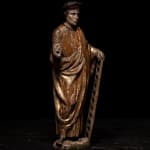Polychromed Statue representing Sint Alexis of Edessa.Flemish school, Belgium
17 3/4 x 7 7/8 x 2 3/4 in
Further images
-
(View a larger image of thumbnail 1
)

-
(View a larger image of thumbnail 2
)

-
(View a larger image of thumbnail 3
)

-
(View a larger image of thumbnail 4
)

-
(View a larger image of thumbnail 5
)

-
(View a larger image of thumbnail 6
)

-
(View a larger image of thumbnail 7
)

-
(View a larger image of thumbnail 8
)

La version grecque de sa légende fait d'Alexis l'unique fils d'Euphemianus, un riche Romain chrétien de la classe sénatoriale. Alexis a fui son mariage arrangé pour suivre sa vocation sainte. Déguisé en mendiant, il a vécu près d'Édesse en Syrie, acceptant l'aumône même de ses propres esclaves domestiques, qui avaient été envoyés pour le chercher ; ils ne l'ont pas reconnu jusqu'à ce qu'une icône miraculeuse de la Bienheureuse Vierge Marie le désigne comme un "Homme de Dieu". Fuyant la notoriété qui en résultait, il est retourné à Rome, tellement changé que ses parents ne l'ont pas reconnu, mais en bons chrétiens, ils l'ont accueilli et abrité pendant dix-sept ans, qu'il a passés dans un coin sombre sous l'escalier, priant et enseignant le catéchisme aux enfants. Après sa mort, sa famille a trouvé une note sur son corps qui leur indiquait qui il était et comment il avait vécu sa vie de pénitence depuis le jour de son mariage, par amour pour Dieu. La vie de saint Alexis est racontée dans un poème français, "la Vie de saint Alexis", qui remonte au début ou au milieu du XIe siècle. Cela est considéré comme l'une des premières œuvres de la littérature française.
Die griechische Version seiner Legende stellt Alexis als den einzigen Sohn des Euphemianus dar, einem wohlhabenden christlichen Römer aus dem senatorischen Stand. Alexis floh vor seiner arrangierten Ehe, um seinem heiligen Beruf zu folgen. Verkleidet als Bettler lebte er in der Nähe von Edessa in Syrien und akzeptierte Almosen sogar von seinen eigenen Haussklaven, die geschickt wurden, um ihn zu suchen; sie erkannten ihn nicht, bis eine wunderbare Ikone der Seligen Jungfrau Maria ihn als "Mann Gottes" auswies. Um der daraus resultierenden Bekanntheit zu entkommen, kehrte er nach Rom zurück, so verändert, dass ihn seine Eltern nicht erkannten, aber als gute Christen nahmen sie ihn auf und beherbergten ihn siebzehn Jahre lang, die er in einem dunklen Winkel unter der Treppe verbrachte, betend und den Kindern Katechismusunterricht erteilend. Nach seinem Tod fand seine Familie eine Notiz auf seinem Körper, die ihnen mitteilte, wer er war und wie er sein Leben der Buße seit dem Tag seiner Hochzeit aus Liebe zu Gott gelebt hatte. Das Leben des heiligen Alexis wird in einem französischen Gedicht namens "La Vie de Saint Alexis" erzählt, das auf den Anfang oder die Mitte des 11. Jahrhunderts zurückgeht. Dies wird als eines der frühesten Werke der französischen Literatur angesehen.
Provenance
Private Collection Bruges BelgiumJoin our mailing list
* denotes required fields
We will process the personal data you have supplied in accordance with our privacy policy (available on request). You can unsubscribe or change your preferences at any time by clicking the link in our emails.







